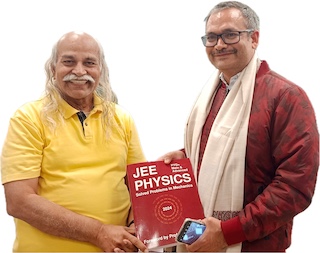Kinematics of rolling without slipping
In a moving bicycle, its wheel while rotating also covers a linear distance forward. If a body undergoes rotational as well as translational motion on a hard surface, it is said to be rolling. A rolling without slipping is called pure rolling.
In this demonstration we try to find the relation between the velocities of the center and top of the rolling cylinder.
You need a uniform cylindrical body (roller), and two 12 inch scales.
- Place the roller on the table near one of the scales such that the distance moved by the roller can be measured on the scale.
- Now place another scale on top of the roller. The point in contact of the scale with the roller shows the zero mark.
- Move the roller forward with the help of the scale above it. Make sure that the scale is always in contact with the roller and it does not slip on the roller.
- Stop when the point in contact of the scale above the roller shows 12 inches.
- Note the distance moved by the roller in the scale placed beside it.
- See that the roller has travelled only 6 inches.
The reading on the scale touching the top of the roller is double the reading on the scale placed beside it. This clearly means the top of the roller has travelled double the distance as compared to the distance moved by the whole roller in the same time. This means that the velocity of the top of the roller is twice the velocity of the roller itself. The velocity of the roller is equal to the velocity of the center of mass of the roller. So we can say that the velocity of the center of mass is half the velocity of the top in pure rolling. If \(\omega\) is the angular velocity of the roller of radius \(r\) then velocities of the point a, b, and c are \(v_a=0\), \(v_b=\omega r\), and \(v_c=2\omega r\). This demonstration shows that velocity of the point c is twice the velocity of the point a.
The same result can be arrived without the use of scales. Both our hands are identical and hence can replace the two scales. Just place the roller at the periphery of the palm and place the finger of the other hand on top of the roller and roll it. We see that although the roller moves one hand distance the hand touching the top of the roller moves two hand distance. This again proves that the velocity of top is twice the velocity of the center of mass of the roller.
Related
Subscribe to our channel
